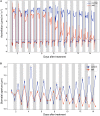Physiological Changes in Mesembryanthemum crystallinum During the C3 to CAM Transition Induced by Salt Stress
- PMID: 32256510
- PMCID: PMC7090145
- DOI: 10.3389/fpls.2020.00283
Physiological Changes in Mesembryanthemum crystallinum During the C3 to CAM Transition Induced by Salt Stress
Abstract
Salt stress impedes plant growth and development, and leads to yield loss. Recently, a halophyte species Mesembryanthemum crystallinum has become a model to study plant photosynthetic responses to salt stress. It has an adaptive mechanism of shifting from C3 photosynthesis to crassulacean acid metabolism (CAM) photosynthesis under stresses, which greatly enhances water usage efficiency and stress tolerance. In this study, we focused on investigating the morphological and physiological changes [e.g., leaf area, stomatal movement behavior, gas exchange, leaf succulence, and relative water content (RWC)] of M. crystallinum during the C3 to CAM photosynthetic transition under salt stress. Our results showed that in M. crystallinum seedlings, CAM photosynthesis was initiated after 6 days of salt treatment, the transition takes place within a 3-day period, and plants became mostly CAM in 2 weeks. This result defined the transition period of a facultative CAM plant, laid a foundation for future studies on identifying the molecular switches responsible for the transition from C3 to CAM, and contributed to the ultimate goal of engineering CAM characteristics into C3 crops.
Keywords: C3 to CAM transition; Mesembryanthemum crystallinum; photosynthesis and photorespiration; physiology; salt stress.
Copyright © 2020 Guan, Tan, Kelley, Tian and Chen.
Figures





Similar articles
-
Possible roles for phytohormones in controlling the stomatal behavior of Mesembryanthemum crystallinum during the salt-induced transition from C3 to crassulacean acid metabolism.J Plant Physiol. 2021 Jul;262:153448. doi: 10.1016/j.jplph.2021.153448. Epub 2021 May 21. J Plant Physiol. 2021. PMID: 34058643
-
Molecular changes in Mesembryanthemum crystallinum guard cells underlying the C3 to CAM transition.Plant Mol Biol. 2020 Aug;103(6):653-667. doi: 10.1007/s11103-020-01016-9. Epub 2020 May 28. Plant Mol Biol. 2020. PMID: 32468353
-
Comparative proteomics of Mesembryanthemum crystallinum guard cells and mesophyll cells in transition from C3 to CAM.J Proteomics. 2021 Jan 16;231:104019. doi: 10.1016/j.jprot.2020.104019. Epub 2020 Oct 16. J Proteomics. 2021. PMID: 33075550
-
Shifting photosynthesis between the fast and slow lane: Facultative CAM and water-deficit stress.J Plant Physiol. 2024 Mar;294:154185. doi: 10.1016/j.jplph.2024.154185. Epub 2024 Jan 28. J Plant Physiol. 2024. PMID: 38373389 Review.
-
Facultative crassulacean acid metabolism (CAM) plants: powerful tools for unravelling the functional elements of CAM photosynthesis.J Exp Bot. 2014 Jul;65(13):3425-41. doi: 10.1093/jxb/eru063. Epub 2014 Mar 18. J Exp Bot. 2014. PMID: 24642847 Review.
Cited by
-
Genomic and transcriptomic analysis of sacred fig (Ficus religiosa).BMC Genomics. 2023 Apr 12;24(1):197. doi: 10.1186/s12864-023-09270-z. BMC Genomics. 2023. PMID: 37046210 Free PMC article.
-
Salinity and Salt-Priming Impact on Growth, Photosynthetic Performance, and Nutritional Quality of Edible Mesembryanthemum crystallinum L.Plants (Basel). 2022 Jan 26;11(3):332. doi: 10.3390/plants11030332. Plants (Basel). 2022. PMID: 35161313 Free PMC article.
-
Salt stress alters membrane lipid content and lipid biosynthesis pathways in the plasma membrane and tonoplast.Plant Physiol. 2022 Jun 1;189(2):805-826. doi: 10.1093/plphys/kiac123. Plant Physiol. 2022. PMID: 35289902 Free PMC article.
-
Bringing CAM photosynthesis to the table: Paving the way for resilient and productive agricultural systems in a changing climate.Plant Commun. 2024 Mar 11;5(3):100772. doi: 10.1016/j.xplc.2023.100772. Epub 2023 Nov 21. Plant Commun. 2024. PMID: 37990498 Free PMC article. Review.
-
Defining Mechanisms of C3 to CAM Photosynthesis Transition toward Enhancing Crop Stress Resilience.Int J Mol Sci. 2023 Aug 22;24(17):13072. doi: 10.3390/ijms241713072. Int J Mol Sci. 2023. PMID: 37685878 Free PMC article. Review.
References
-
- Amor N. B., Hamed K. B., Debez A., Grignon C., Abdelly C. (2005). Physiological and antioxidant responses of the perennial halophyte Crithmum maritimum to salinity. Plant Sci. 168 889–899. 10.1016/j.plantsci.2004.11.002 - DOI
LinkOut - more resources
Full Text Sources
Miscellaneous

